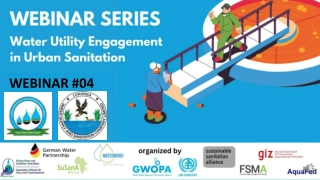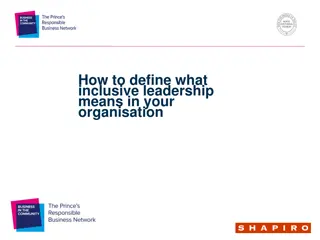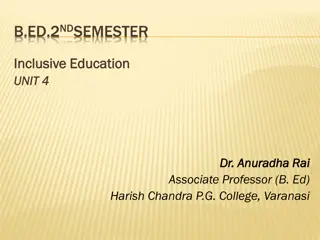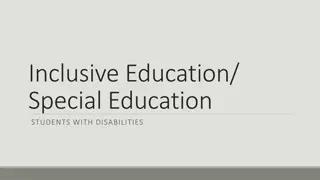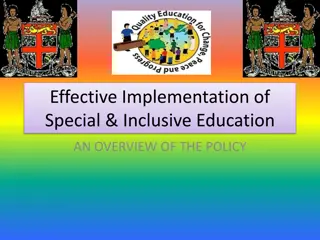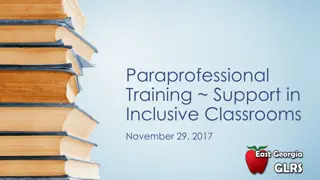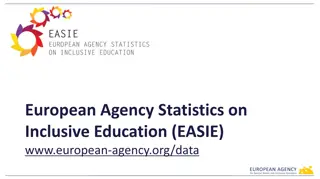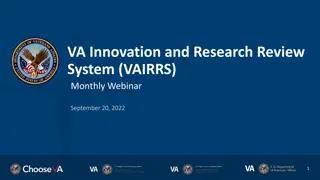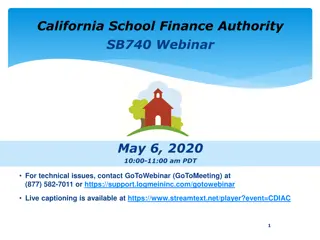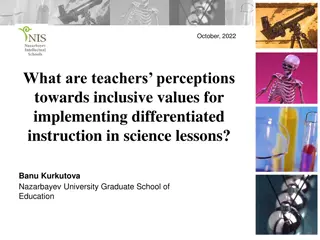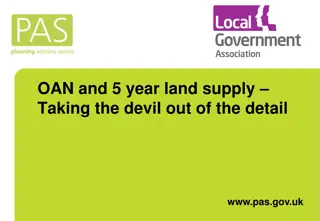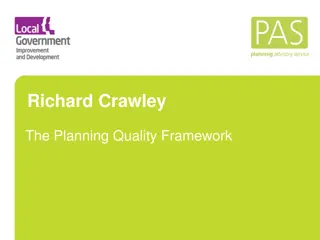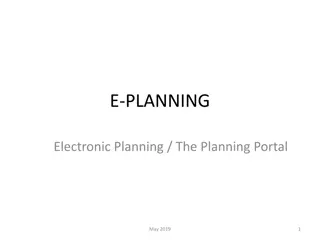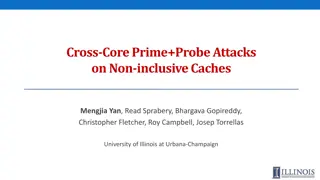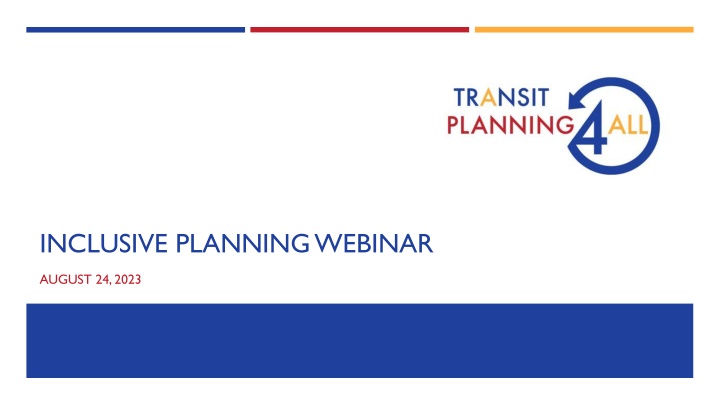
Promoting Inclusive Transit Planning for All | August 24, 2023 Webinar
Join us on August 24, 2023, for an informative webinar on Transit Planning 4 All, focusing on inclusive planning practices supported by the US Department of Health and Human Services Administration on Community Living. Learn about diverse demonstration grants, team introductions, and the importance of inclusion in transportation planning. Discover how involving people with disabilities and older adults leads to more responsive transportation systems.
Download Presentation

Please find below an Image/Link to download the presentation.
The content on the website is provided AS IS for your information and personal use only. It may not be sold, licensed, or shared on other websites without obtaining consent from the author. If you encounter any issues during the download, it is possible that the publisher has removed the file from their server.
You are allowed to download the files provided on this website for personal or commercial use, subject to the condition that they are used lawfully. All files are the property of their respective owners.
The content on the website is provided AS IS for your information and personal use only. It may not be sold, licensed, or shared on other websites without obtaining consent from the author.
E N D
Presentation Transcript
INCLUSIVE PLANNING WEBINAR AUGUST 24, 2023
WEBINAR LOGISTICS This event is being recorded. There is ASL interpretation and auto captioning. To turn on captions, click the button in the control bar labelled Captions. If you are having technical difficulties, please send a private chat to Grayson Lee. Please keep your sound on mute. If called on to speak, please identify yourself. Feel free to share thoughts and comments in the chat. We will have a Q&A at the end of the event for attendees to ask questions.
AGENDA What is Transit Planning 4 All? Overview of inclusion How can we monitor inclusion? Q&A Introduction to the Accessible Transportation Resource Center
WHAT IS TRANSIT PLANNING 4 ALL? TP4A is a transportation planning project focused on promoting the practice of inclusive planning. Funded through the US Department of Health and Human Services Administration on Community Living Goal: Support communities across the country to adopt proven, sustainable, and replicable models that lead to participation of persons with disabilities, older adults, and caregivers in the design and implementation of coordinated transportation systems that are responsive to their needs.
DEMONSTRATION GRANTS More than 40 sites total Diversity of type, size, geographic location Variety of roles in transportation planning Diversity in focus/ desired outcomes of project efforts
TRANSIT PLANNING 4 ALL TEAM INTRODUCTIONS Virginia Dize Charlie Rutkowski Melissa Gray Grayson Lee David Somers David Hoff David Bernstein DeBrittany Mitchell
HOW DO WE DEFINE INCLUSION? The active and meaningful involvement of people with disabilities and older adults in transit planning and operations.
WHY INCLUSION? Programs that include people with disabilities and older adults in transportation planning are better able to address their needs. Ensuring diversity through inclusion improves the ability of programs to address a diversity of needs. Nothing about us without us.
INVITING AND WELCOMING Outreach through variety of methods Various and trusted communication methods Use of trusted partners Don t expect everyone to come to your house
PROACTIVE CONSIDERATION OF NEEDS Apply universal design principles Support needs and assistance Language and cultural considerations Resource: Tip-Sheet: Planning Inclusive Meetings, Going Beyond the ADA to Make Your Meeting Place User-Friendly (https://transitplanning4all.org/resources/tip-sheet-planning- inclusive-meetings/)
ACTIVE AND MEANINGFUL INVOLVEMENT More than asking opinion Opportunities to be involved at variety of levels and variety of ways Multiple ways of providing input and being engaged
EXAMPLES OF STRATEGIES FOR INCLUSION 1. Overall culture of engagement and inclusiveness 2. Ability to participate remotely and in-person 3. Ensuring understanding of methods/mechanisms for transportation planning 4. Technology (access, knowledge, comfort) 5. Time, place, easy access 6. Opportunities and concrete roles 7. Easy availability of accommodations and support 8. Training and capacity-building: staff and community members
THE PATHWAY TO INCLUSION Inspiration: Arnstein Ladder of Citizen Participation. Participants: People with disabilities, older adults, caregivers. Levels 1-3: Necessary, but less communication, decreased trust, and less inclusive. Levels 4-6: Aspirational! More communication, increased trust, and more inclusive. Programs conduct activities at all levels needed. Inclusive programs should be able to provide examples of inclusive activities at different levels. 1 3
PATHWAY LEVEL 1 Programs Developed for Participants Purpose: Mobility programs are needed for people with disabilities and older adults to live active, meaningful lives. Little or no involvement of participants. Assumption: Few programs continue at Level 1 because success is unlikely without participant involvement. Level 1 Examples: Too many to list. That s why ACL funded Transit Planning 4 All. 1 4
PATHWAY LEVEL 2 Inform Participants About Programs Purpose: Communicate to stakeholders. Programs provide information to current and potential participants. Communication is generally one-way (from program to participants). Examples: Brochures, websites, emails, social media, community presentations by program staff or consultants. 1 5
PATHWAY LEVEL 2: EXAMPLES Inform Participants About Programs Participant attended all weekly meetings and community conversations. 33 people with disabilities, older adults, and/or caregivers attended our summit. Program developed a brochure about paratransit and distributed them at a community fair. Information about transit options provided as tax bill insert. 1 6
PATHWAY LEVEL 3 Consult Participants about Programs Purpose: Collect feedback from participants about current services, unmet needs, and potential services. Programs have individual or group discussions or data collection from people with disabilities and older adults. Examples: Surveys, focus groups, community meetings. 1 7
PATHWAY LEVEL 3: EXAMPLES Consult Participants about Programs People with disabilities and caregivers were interviewed for a newsletter. One disabled person shared transportation barriers regarding blindness. Transit agency collects surveys once a year to gather feedback. A regional planning agency, working with transit providers, held a public hearing about services and invited transit users to attend. 1 8
PATHWAY LEVEL 4 Active Participant Involvement in Programs Purpose: Build credibility; expand resources. Participants, through steering committees or other activities, play active, meaningful roles in planning and program activities that serve people with disabilities and older adults. Examples: Participants lead person-centered activities; participants review program materials. 1 9
PATHWAY LEVEL 4: EXAMPLES Active Participant Involvement in Programs One person with a disability did outreach to immigrant community. Participants designed surveys, conducted outreach, made meeting logistics, and meeting involvement. Participants conducted peer-to-peer interviews. Participants organized into committees to carry out program activities. Prototype ideas to address transit wayfinding issues were developed and tested with participants. 2 0
PATHWAY LEVEL 5 Participants Share Decision Making Purpose: Decision-making expands influence ( Nothing about us without us. ). Participants share in the process of making decisions regarding planning and operations of programs. Examples: Participants consider program and policy alternatives, share influence in decision-making. 2 1
PATHWAY LEVEL 5: EXAMPLES Participants Share Decision Making Program staff and participants worked on future plans for the project. The project Steering Committee decided which 2 approaches to adopt. I would like to share my feelings in regards to the process and participation of being part of Transportation Committee. I felt this was a great experience. I felt my opinion mattered. I was treated with respect and included to participate. 2 2
PATHWAY LEVEL 6 Participants Play Lead Roles Purpose: Programs for people with disabilities and older adults are led by participants. Individual participants (not representing partner organizations) take on leadership roles in program planning and operations. Examples: Participants assume leadership responsibility for planning and carrying out project tasks. 2 3
PATHWAY LEVEL 6: EXAMPLES Participants Play Lead Roles A mother of a disabled child (caregiver) offered to train project staff on how to work with children with disabilities. A person with a disability contacted the city s transit department to notify them about the Transit Planning 4 All grant availability and worked on the grant proposal. Upon award she/he became the Co-Project Director. Unprompted, a homeless project volunteer provided training on a mobility on demand (MOD) phone app to other homeless shelter residents so they could receive transit services. 2 4
USE THE PATHWAY TO INCLUSION 1. TRACK inclusive activities. 2. REVIEW inclusive activities (inclusively). 3. SCORE the Pathway Level for each activity. 4. IDENTIFY the overall Pathway Level. 5. REPORT overall Pathway Level (transparency). 6. EXPAND inclusive activities. 25
SUGGESTED MEASURES FOR MONITORING INCLUSION Outputs # of participants on steering committees # of participants who attended meetings # of inclusion/participation needs/barriers/problems identified by participants # of inclusion/participation solutions identified by participants Outcomes # of additional or new participants engaged in planning process # of inclusion/participation barriers/problems vetted/referred to responsible parties # of inclusion/participation solutions implemented (partially or fully) Satisfaction Measures % of participants satisfied with the planning process % of stakeholders/partners satisfied with the planning process % of participants who felt their opinions had an impact on planning, activities
Q & A INCLUSIVE PLANNING WEBINAR AUGUST 24, 2023
ACCESSIBLE TRANSPORTATION RESOURCE CENTER (ATRC) New center, funded through the Administration on Community Living, with a focus on identifying and disseminating best practices in transportation accessibility and serving as a hub for transportation accessibility resources. Steering Committee - 15 members with diverse representation National Accessible Transportation Accelerator Network (NATAN) Call for accessible transportation strategies to be housed on ATRC website Communities of Practice Goal: increase transportation access and use in historically underserved communities 5 Communities of Practice, with at least 2/5 rural Email ATRC: atrc@acl.hhs.gov

